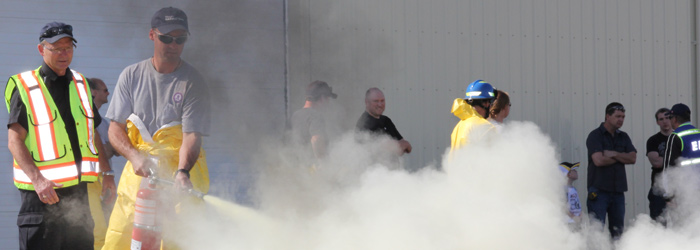Q&A

What is my role as Building Emergency Team (BET) in the event of alarm?
Your primary role is to assist people to get out of the building safely and quickly, by the closest exit.
What steps should be followed in the event of alarm if you are in your area?
- Don your BET vest
- Take your keys, coat and any important information with you
- Search your floor only if you can do so safely
- Encourage all occupants to close doors to their area, and evacuate the building
My area is the 5th floor. I am on the 4th floor when the alarm is activated. Should I go up to my floor to do my BET duties?
“NO” ‐ you should exit the building and inform officials that you were not able to complete your duties
What do I do when someone refuses to leave in the event of alarm?
- Inform them there is an alarm and that everyone must exit the building
- If they choose not to leave, do not get confrontational, continue with your duties and inform officials
What equipment needs to be shut down safely in the event of alarm?
Any equipment that poses a hazard to persons or property that can be easily stopped
Where do 911 calls go?
- From any campus phone to Campus Safety and Emergency Services (CSES)
- From any other phone (ie: mobile) London Police Services (which will be redirected to CSES)
What do I do if there is a person with disability in my area during alarm?
For person who can not evacuate seek a safe area such as an office, classroom, bedroom suite, stairwell and call 911
Severe weather emergency. Would our role be to encourage people to stay in the building?
“Yes” ‐ advise people to move away from the exterior walls windows and into the core of the buildings.
When is it safe to re‐enter a building?
Once the Fire department has given the all clear or when the signalling devices stop.
Can students be BET’s?
Yes” – where practical, Fire Safety can provide training if necessary.
Does Fire Safety provide Fire Extinguisher training?
“Yes ‐ it’s free on a first come first serve basis. Sign up via email at “Firesafety@uwo.ca”
During evacuation ‐ how far should people move away from a building?
In the winter time it is tempting to stay close to the door. Be mindful of the Fire Department coming in as they need the space. Getting people farther than 10 metres would be our recommendation.
Are graduate students aware of these processes for exiting?
“Yes” ‐ it is important that the BET’s report problem areas so we can intervene when necessary
Is the live burn video available on Website?
“Yes” – you can find video on the Fire Safety Website.
If someone in our facility has a medical emergency and a 911 call is made from a cell phone, what happens?
What is the management strategy, during an evacuation, for persons with mobility problems?
In traditional residences persons with permanent disabilities are on a list and during fire alarms these persons are contacted by telephone and updated on the situation. In other circumstances areas of refuge are offices or suites and stairwells or landings. Persons can choose to remain in an office or suite and call Campus 911 and apprise the Communications Operator of their situation or they can wait in a stairwell or landing area but they should ensure that someone can report their location to the responding emergency personnel. Building emergency team members are encouraged to stay with the impaired person(s), but that is not always possible.
